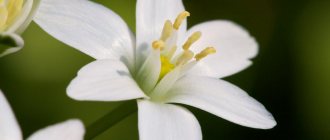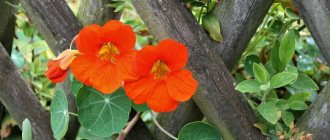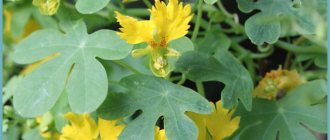Climbing nasturtium is a real find for those who want to decorate their garden. If you dream of beautifying the unsightly parts of your dacha, you can’t do without it.
In appearance, the plant is a decorative vine with bright green dense leaves and small flowers of various colors. Today there are varieties with red, cherry, yellow and orange flowers, and there are also “hybrid” colors that are highly decorative. Double and semi-double flowers produce unusually lush blooms, but simple, smooth flowers are also beautiful.
In its natural environment, nasturtium is a perennial plant.
In its natural environment, nasturtium is a perennial plant, but the harsh winters of Russia force gardeners to cultivate it as an annual.
Useful properties of nasturtium
In addition to its attractive appearance, nasturtium has a number of healing properties. The content of useful microelements in its various parts has led to the fairly wide use of the plant in traditional and folk medicine, cosmetology and cooking.
Nasturtium contains:
- vitamins (A, C, PP);
- trace elements (iron, iodine, potassium, calcium, magnesium, copper, phosphorus);
- antioxidants (Omega-3, Omega-9);
- antiseptic substances;
- alkaloids;
- anthocyanins;
- glycosides;
- tannins;
- carotene;
- acids (linoleic, oleic, palmitic, stearic, folic);
- tocopherol;
- tropeolin and other substances.
The presence of useful substances promotes the use of decoctions and infusions from capuchins for the following purposes:
- removing excess cholesterol from the body;
- providing a mild analgesic effect;
- laxative action;
- treatment of various skin and oral diseases;
- lowering blood pressure;
- normalization of the condition in cardiovascular diseases;
- increasing hemoglobin content in the blood;
- softening of formations in urolithiasis;
- treatment of diseases of the broncho-pulmonary system;
- improvement in problems with the digestive system.
However, there are certain contraindications for the use of nasturtium:
- period of pregnancy and breastfeeding;
- children's age (up to 7 years);
- arterial hypotension;
- problems with stool with a predominant laxative effect.
To enhance growth and improve the general condition of hair, nasturtium infusions and decoctions, including alcoholic ones, are used.
In order for the plant to retain the maximum amount of useful substances, it should be properly collected, dried and stored. For medical purposes, it is harvested during the formation of the first buds. Dried raw materials are stored in a dry and cool place in bags made of breathable materials for 1-2 years.
Nasturtium also continues to be used in cooking today. It is pickled and added to fresh salads. When dried, the crushed seeds are used as a seasoning for hot dishes, and the flowers are used to flavor tea.
Care
Watering
The large mass of green leaves and stems requires regular watering. Young plants especially need water during the growth period and in dry, hot weather. An adult nasturtium can easily tolerate short breaks in watering. Surprisingly, a plant torn out of the ground does not wither for a long time and continues to bloom - it is helped by the moisture accumulated in the succulent stems. After watering, the soil around the plantings is loosened and weeded.
Feeding
Nasturtium does not tolerate fertilizers with fresh organic matter and is responsive to phosphorus-potassium fertilizers. Nitrogen fertilizers are best used as foliar sprays. It is useful to treat young plants 1–2 times with a solution of urea or humate. The nasturtium bushes will become strong, the leaves will be powerful and bright green. Plants are fed with complex mineral fertilizers every 4–6 weeks.
How to prolong flowering?
Flowering of nasturtium begins 1–1.5 months after emergence and lasts until frost. To ensure long flowering without interruptions, faded flowers are regularly plucked off - this stimulates the formation of new buds. Only those inflorescences from which ripe seeds will be collected are left.
Propagation of nasturtium
There are several ways to propagate the plant. The two main ones are seed and cuttings. For certain types of crops, propagation by air layering and tubers is possible.
Seeds
Nasturtium is easily propagated by seeds, both home-collected and purchased. In addition, this can also happen during self-sowing. The seeds overwinter well under thick snow and sprout in the spring.
Seeds can be planted in open ground or pre-grown seedlings from them. It should be noted that in the latter case, the flowering of the crop occurs at an earlier date.
Before planting, seed material is soaked for a day in warm water, which softens its hard shell and increases germination. For disinfection, you can add several crystals of potassium permanganate to the water.
The optimal time to start growing seedlings is mid-April. For this purpose, small containers with a diameter of 6-8 cm are suitable, which are filled with loose nutritious soil consisting of turf soil, sand and peat in equal proportions. A drainage layer of expanded clay, pebbles or similar materials is laid on the bottom. It is good to use peat pots in which the seedlings are immediately planted in the ground.
In each such container, make a small depression of 1.5-2.0 cm, put 2-3 seeds, carefully water them with water at room temperature and cover them with earth. Then the containers are placed in a warm and well-lit place, but out of direct sunlight and drafts.
To speed up germination, a greenhouse effect is created by covering the containers with plastic film or similar material. However, it should be removed regularly to ventilate the crops, and after the first shoots appear, it should be removed. If several sprouts appear, the weaker ones are cut off at the root.
Important! Picking (pulling out) sprouts is not done due to the fragile and branched root system of nasturtium, so as not to harm other seedlings.
Seedlings must be watered regularly, avoiding dry soil. For this purpose it is better to use a spray bottle. The optimal water temperature for irrigation is + 18-20°C, which helps to harden plants and inhibit their growth.
If there is insufficient natural light (the first sign is weak and elongated sprouts), it is necessary to organize additional artificial light using special lamps or lamps.
On average, 2 weeks before planting seedlings in open ground, they begin to harden them, taking them out into fresh air with a gradual increase in residence time. During this period, the flowers become ready to stay outside around the clock.
Cuttings
It is quite easy to propagate nasturtium from seeds. However, in some cases they do not fully convey all the characteristics of the mother crop, and in some varieties (for example, terry) seeds do not form at all.
With such options, it is advisable to use the method of propagation by cuttings.
Cuttings are prepared for rooting in late May - early June. The strongest and healthiest shoots with 2-3 internodes in each are separated from the mother plant. The process of root formation can occur first in containers with water, and then in soil consisting of peat and river sand in equal proportions. It is recommended to add activated carbon to the water, and also change it once every 4-5 days.
When the roots grow 2-3 cm, the cuttings are planted in the ground. To maintain high humidity, which favors accelerated growth, they are covered with a plastic bag on top. The appearance of new shoots and young leaves is a sign of successful rooting. Only after the plant has become completely strong is it planted in a permanent place.
Air layering
This method of reproduction is relevant for those species of capuchins that have creeping shoots. They are lightly sprinkled with soil and kept moist. After 3-4 weeks, independent roots will form in such areas. They are separated from the main plant and grown.
Tubers
Reproduction by tubers is possible only in those types of nasturtium that have them or form them (tuberiferous, multileaf). Due to the division of powerful elongated tubers, further development of new plants occurs.
Pest and disease control
Nasturtium is susceptible to fungi and rot, which causes the leaves to turn white and become covered with plaque. All this can be treated well with modern complex fungicides. If the leaves also curl, it is probably due to bacterial wilt, and there is no point in treating it.
Nasturtiums are loved by caterpillars, and their most characteristic feature is holes in the leaves. Bugs, midges and aphids willingly settle on flowers, because this is an effective green manure that takes the blow of pests upon itself. In such cases, use industrial insecticides or ash infusion.
Photo: greensotka.ru
Hydrangea (80 photos): types and features of care
Answers to frequently asked questions
Why don't the seeds germinate?
The reason why the seeds do not germinate may be due to their long storage at home or in the store. If there are a lot of seeds, you need to check them in advance for germination by soaking several pieces.
Why are seeds soaked?
Seeds are soaked to test for germination, to encourage them to germinate in open ground and to prevent them from becoming infected with any disease.
How to harden nasturtium seedlings?
Temperature hardening of seedlings: when planting, the container with seedlings is covered with a covering - polyethylene, a lid, etc. to harden, the covering is removed for a while. In turn, the seedlings receive the necessary oxygen and sunlight, which has a beneficial effect on their growth.
The nasturtium seeds have sprouted, what to do next?
As soon as the first shoots appear, the film covering them is removed, and the container itself is placed in a bright place to provide the required amount of light. For proper growth, sunlight should illuminate the shoots for at least 12-16 hours. If there is not enough light for the sprouts, they will begin to stretch in length, then weaken and stop developing. From the moment the sprouts appear, the temperature is maintained in a certain way: it cannot be less than 18 degrees, but it cannot be above 22 either. The emerging shoots require constant watering, depending on the frequency of drying out of the soil.
Features of the plant
Nasturtium is a heat-loving creeping plant with bright single helmet-shaped flowers. The flowers are simple and double, with a diameter of 5 to 7 cm, in orange, yellow, burgundy, red and pink. There are many species of this plant (more than 90 varieties). They are distinguished by the shape and color of flowers, stems, and leaves. But the most popular of them are three: large nasturtium, canary nasturtium, and shield-bearing nasturtium.
Large nasturtium, or May nasturtium. The plant has a branched creeping stem up to 2.5 m long or erect, slightly creeping stems up to 70 cm long, as well as rounded leaves. The flowers of this species are large, irregularly shaped, velvety, with a delicate aroma, on long stalks - pink, yellow, orange, red, brown-red.
Canary nasturtium, or foreign nasturtium , is a vine with small, bright yellow flowers and stems up to 3 m. Its leaves are small, light green in color, and five-parted.
Shield nasturtium, or Lobba. An ampelous crop with a succulent, fragile, branched stem. Creeping shoots reach a length of up to 4 m. The leaves are large, dark green, shield-like. The flowers are the same shape as large nasturtiums, only with a red calyx.
Use in garden design
The flowers of foreign nasturtium, although bright, are not so large as to be clearly visible from a distance. Therefore, it is useful to plant other plants with blue, purple, and red flowers nearby, providing a background for them.
Foreign nasturtium is beautiful in flower beds, on balconies, and in hanging baskets. It can grow in a ground cover crop, but even better - on supports. Effectively wraps around pillars, obelisks, gazebo supports, fences and trellises. The best and most convenient for her are thin supports.
The carved rounded leaves are magnificent on their own, without flowers. But blooming trellises of foreign nasturtium, covered with many yellow “canary” flowers, are an exotic sight.
Bright yellow flowers attract all kinds of beneficial insects to the garden - butterflies, bumblebees, bees. Many gardeners sow nonnasturtium along with wildflowers to create a butterfly garden. But it must be borne in mind that the vigorous growth of the vine can sometimes suppress neighboring non-competitive plants.
In English gardens, this nasturtium can often be seen as part of ornamental vegetable gardens. There is nothing surprising. Its leaves are edible and useful, like the leaves of ordinary nasturtium. However, flowers, seeds and even stems are also edible; they all have a characteristic pungent aroma. Young seeds are used as a replacement for capers, and the leaves and flowers are added to salads. Nasturtium flowers are also used as an additive in butter, soups and, for example, in the national American dish gumbo, which is a cross between a soup and a stew.
Try making something from nasturtium:
LiveInternetLiveInternet
—Quote book
TO BE REMEMBERED. FORGOTTEN NAMES - SOVIET STEP PEOPLE AND TAP DANCERS GUSAKOV BROTHERS Soviet st.
New Year's savory appetizer "5 minutes" Savory appetizers.
VERBENA VERBENA Verbena is a beautiful perennial plant - a real gem.
Skirts, skirts, skirts. (with patterns).
Gardener's calendar for 2016. Puxovaia.
—Tags
—Categories
- House (379)
- My experience of growing plants (65)
- Dacha (85)
- Recipes (51)
- Family (122)
- Retro (16)
- Inheritance. Court (3)
- Interior (185)
- Garden design (99)
- interior of small rooms (14)
- Kitchen design (10)
- Bath and toilet design (7)
- bedroom interior (7)
- Design of the hallway, hall (6)
- loggia design (4)
- Children's room interior (4)
- living room interior (4)
- garden, vegetable garden (149)
- FLOWERS (86)
- Vegetables (31)
- Bushes (14)
- Trees (5)
- Health (69)
- DIY (220)
- Religion (44)
- New Testament (18)
- Old Testament (11)
- Links (339)
- Trivia (259)
- Pictures (67)
- Parenting (77)
- Work (7)
- Metro (1)
—Applications
- I am a photographer
Plugin for publishing photos in the user's diary. Minimum system requirements: Internet Explorer 6, Fire Fox 1.5, Opera 9.5, Safari 3.1.1 with JavaScript enabled. Maybe it will work - Postcards
Reborn catalog of postcards for all occasions - Rating buttons "Yandex.blogs"
Adds Yandex rating buttons to the profile. Plus, graphs of rating changes per month will appear soon - Online game "Empire"
Transform your small castle into a mighty fortress and become the ruler of the greatest kingdom in the game Goodgame Empire. Build your own empire, expand it and defend it from other players. B
—Photo album
-I'm a photographer
—Subscription by e-mail
—Search by diary
—Interests
— Regular readers
-Statistics
Selecting a location
When choosing a place to grow nasturtium, there are two conflicting factors to consider. On the one hand, the flower loves places open to the sun, on the other hand, it is afraid of winds. In the shade, flowering will be faded and sparse, and when there are gusts of wind, the stems break very easily. Regarding the soil, the wishes boil down to good drainage, light structure and low acidity. You should not overly stuff the soil with organic matter, this will give an undesirable advantage towards green mass instead of flowering. But too poor lands will not give the desired result. The foliage will be small, and the planting will look half-bald, with the soil showing through.
Nasturtium seedlings grown in low light conditions subsequently suffer for a long time after being transplanted into the ground and may not produce color.
Description
The plant in its natural habitat is a perennial, however, in the harsh Russian climate, nasturtium can only be grown as an annual, due to the delicate structure of its roots. But the flowering period of nasturtium is long, and it has an extremely unpretentious character, for which it is especially loved by gardeners.
Nasturtium is widely used in landscape design. It can be used to decorate flower beds, borders, hanging flowerpots, and to carry out vertical gardening of trellises, gazebos, even the walls of a house.
Nasturtium from seeds
The flowers of the plant are small - about 5 cm in diameter; simple varieties have five petals, double ones - more. The color of the petals is varied: the entire palette of yellow and red is represented, as well as transitional shades between these colors. There are also two-color specimens that are particularly decorative. Now breeders have already developed nasturtium varieties with such unusual petal colors as cherry, cream, raspberry, and pink.
Video shows how to grow Nasturtium from seeds:
The flower itself is a funnel, decorated with a small decorative proboscis, which serves for pollination. The aroma of nasturtium is very pleasant, sweetish, delicate.











